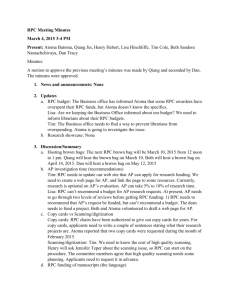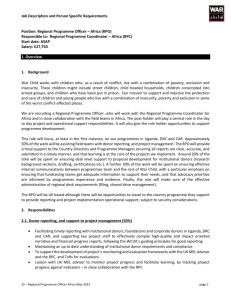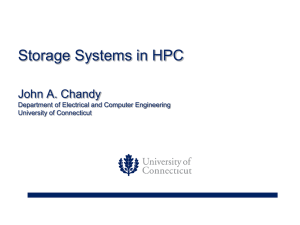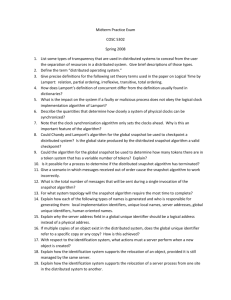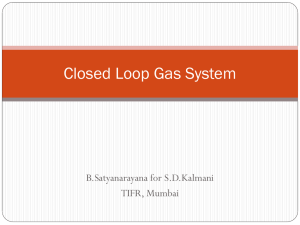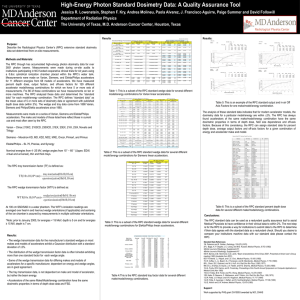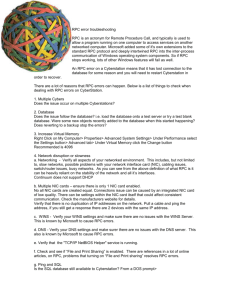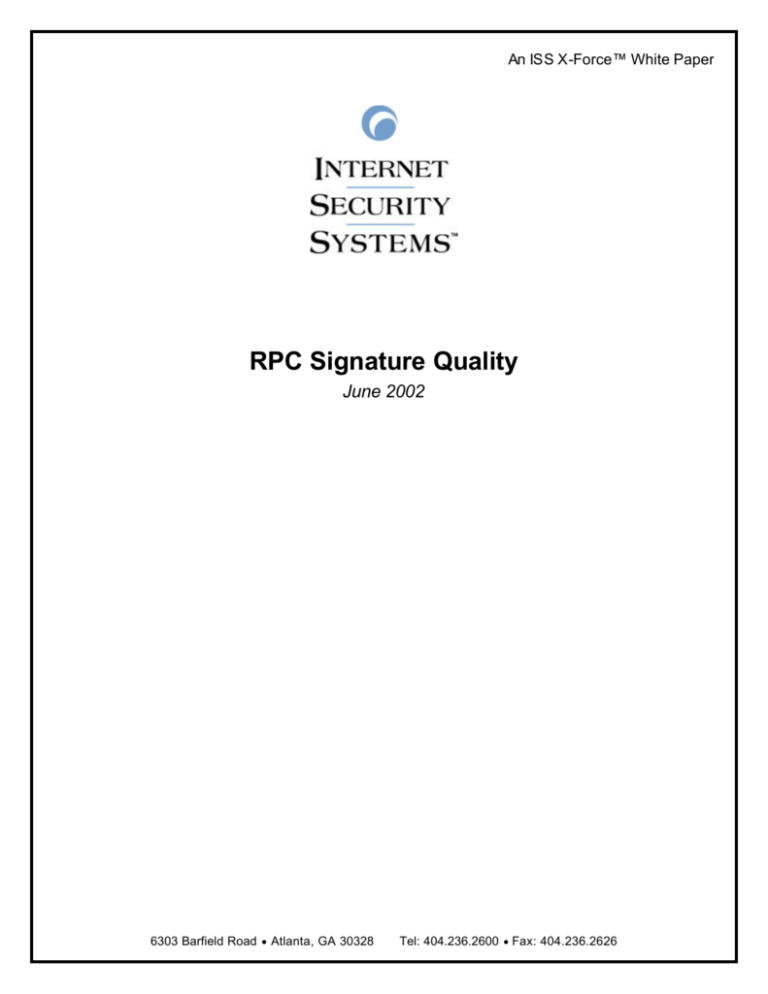
An ISS X-Force™ White Paper
RPC Signature Quality
June 2002
6303 Barfield Road • Atlanta, GA 30328
Tel: 404.236.2600 • Fax: 404.236.2626
IDS Signature Quality
Introduction
There is a significant difference in the quality of signatures shipped with popular Intrusion
Detection Systems. This paper highlights these by focusing on signatures developed for the Sun
Microsystem RPC (Remote Procedure Call) system. Overall, Internet Security Systems’
RealSecure® Protection System, particularly the RealSecure® Network Sensor, has a
significant advantage in the effectiveness and quality of these signatures over competing
Intrusion Detection Systems and their RPC signatures.
Why the Snort Analysis
RealSecure Network Sensor supports the importing of Snort signatures, which allows RealSecure
to become the superset of signatures for BlackICE™ Sentry (now integrated into RealSecure
Network Sensor 7.0), RealSecure Network Sensor, and Snort. RealSecure Network Sensor users
can utilize Snort rules to quickly update the program. Although users familiar with Snort can
benefit from this feature, there is a risk involved with using the open source signature rules,
including many false positives and false negatives. While researching the RPC attacks, which are
very popular on Unix and Linux systems, researchers discovered many of the IDS signature
errors presented in this paper.
RPC Scans
Many of Snort’s signatures are written with pattern matching techniques, which result in many
false positives and negatives. In comparison, the protocol analysis techniques used by a few
commercial IDS products result in virtually no false positives or false negatives.
RPC has some characteristics that make pattern matching difficult. RPC operates using both the
TCP and UDP transports and runs on arbitrary ports. This forces the pattern-matching system to
examine all packets rather than focus on patterns specific to certain ports.
Instead of detecting the actual intrusion, most of Snort’s signatures are in the form of:
alert udp $EXTERNAL_NET any -> $HOME_NET 111 (\
msg:"RPC portmap request status"; \
content:"|01 86 B8 00 00|";\
offset:40;depth:8; \
reference:arachnids,15; \
classtype:rpc-portmap-decode; sid:587; rev:2;)
This signature examines incoming Internet traffic for Portmap requests, specifically searching for
0x0186B8, which is the rpc.statd service. These Portmap requests are usually the first stage of
communication with the service. Because the RPC service can use any port, a remote client must
first query Portmap to discover which port the service is currently using.
These Portmap signatures correlate poorly with intrusions. For example, if a network is using
rpc.statd (part of the NFS suite of protocols), a large amount of normal requests for rpc.statd will
be sent across the network. If the signature detects all of this traffic, it would be difficult to
ascertain whether the traffic is normal or malicious.
Snort attempts to address this situation by adding the $EXTERNAL_NET -> $HOME_NET
restriction to the rule. This option restricts the signature to examine inbound traffic from the
Internet. Normally, NFS and rpc.statd are only used within the internal network and are unlikely to
be used for Internet communications. However, while this option solves the problem of too many
false positives, it significantly degrades the performance of the IDS. Snort does not seem suitable
for detecting internal traffic from internal attackers or intruders who are using an internal system
to attack other systems.
Portmap’s port 111 is one of the most common ports filtered at firewalls. This forces attackers to
use other ways of finding RPC services. Rather than query Portmap, they might portscan a
An Internet Security Systems X-Force White Paper
Page 1
IDS Signature Quality
system to figure out where RPC services are running. Once attackers find an RPC service, they
can insert the port number directly into the exploit script. This means the script won’t query
Portmap, and therefore won’t be detected by Snort.
Thus, Snort has an extremely high incidence of false positives and false negatives using this
approach. The Cisco Secure IDS (formerly WheelGroup NetRanger) uses the same technique for
some of its signatures.
RealSecure Network Sensor uses a different approach that relies upon application layer protocol
analysis. Rather than detecting individual rpc.statd lookups using Portmap, RealSecure Network
Sensor analyzes overall rpc.statd traffic. Snort and Cisco detect an early sign that an attack might
occur, while RealSecure detects the actual attack.
RPC Exploits
Snort contains a few signatures that detect actual RPC attacks. An example for rpc.statd is
shown below:
alert udp $EXTERNAL_NET any -> $HOME_NET any (\
msg:"RPC EXPLOIT statdx";\
content: "/bin|c74604|/sh";\
reference:arachnids,442;\
classtype:attempted-admin; sid:1282; rev:1;)
This signature attempts to detect the statdx.c exploit, which takes advantage of the “rpc.statd
format-string vulnerability.” This signature searches for the pattern within the network traffic that
was generated by the attack script.
However, statdx.c isn’t the only script targeting the rpc.statd format-string vulnerability. Another
script uses different source code and will not be detected by this signature. Yet another rpc.statd
exploit has been written for Linux on the PowerPC, which cannot be detected by any signature
searching for Intel x86 machine code.
In addition, a utility called ADMutate can be used to encrypt the part of network traffic that Snort
examines. If ADMutate is combined with the statdx.c script, Snort’s signature will be unable to
detect this attack.
RealSecure Network Sensor uses a different technique for detecting the rpc.statd exploit. The
original vulnerability that these scripts exploit is a format-string bug in certain rpc.statd fields.
RealSecure Network Sensor decodes the rpc.statd protocol, breaks apart the individual fields,
and analyzes them for format-string contents. All attack scripts (including those encrypted by
ADMutate) are detected by this protocol-analysis signature.
For example, the following screenshot of the Ethereal packet analyzer shows a protocol decode
of the packet generated by the statdx.c exploit.
An Internet Security Systems X-Force White Paper
Page 2
IDS Signature Quality
Ethereal is a typical packet analyzer. The top pane shows a packet-by-packet summary. The
second pane shows the detail of each field in the packet. The bottom pane shows a hex
(hexadecimal) dump of the packet contents. Because of the size of this packet, the data between
offsets 0x0d0 through 0x03a0 has been edited for brevity.
The protocol analysis technique used by RealSecure yields a field-by -field decode of the packet
using the same methods as Ethereal uses to display the contents in the details pane. The last
field of the packet is the 999-byte Filename field. RealSecure analyzes this field and searches its
contents for format-string specifiers. If the field is longer than 100 bytes and has more than one
format-string specifier, RealSecure triggers a Statd_Format_String alert. The two portions of the
string that RealSecure examines are highlighted in red.
In contrast, Snort’s signature searches the packet contents within the UDP packet. It treats
everything following the UDP header as generic data and doesn’t interpret any of the fields. The
portion found by Snort is highlighted in green in the above picture.
Note that ADMutate would encrypt the portion highlighted in green, but cannot encrypt the portion
highlighted in red.
An Internet Security Systems X-Force White Paper
Page 3
IDS Signature Quality
Snort has only two signatures for rpc.statd: the Portmap lookup described in the previous section
and the statdx.c exploit script. RealSecure includes detection for a Solaris buffer overflow
vulnerability, a dot-dot directory climbing vulnerability, fingerprinting of popular vulnerability
scanners, and detection of a subtle vulnerability that passes rpc.automount requests through
rpc.statd. RealSecure also has generic Portmap lookup signatures that detect failed attempts,
indicating hacker sweeps.
Like Snort, most of Cisco Secure IDS signatures focus on Portmap lookups rather than actual
intrusions. However, it detects sweeps, which are hacker scans of multiple computers for a
vulnerable RPC service. Cisco decodes the RPC header but not the application layer. This allows
it to work more like RealSecure by detecting intrusions caused by abnormal lengths.
Unfortunately, it checks the length of the entire RPC request rather than the length of application
layer fields. This can lead to false positives since RPC packets can be very long. In other words,
when a certain rpc.statd field exceeds 255 bytes, it is ALWAYS an intrusion. However, when an
rpc.statd packet itself exceeds 255 bytes, it is only USUALLY an intrusion.
RPC State-Based Signatures
Systems like Snort and Cisco are stateless. This means they analyze single packets without
correlating information among multiple packets. In contrast, RealSecure is a stateful system.
For example, the RealSecure NfsGuess signature detects when an attacker tries many different
file handles. Much of NFS security is based on file handles being hard to guess. If an attacker is
given enough time, he or she may be able to guess file handles and will be able to access the
rest of the system. To detect file handle guessing, RealSecure maintains a list of the file handles
that are in use. When enough failed guesses occur, RealSecure can then generate an alert.
Another example is RealSecure’s inclusion of returned data. When an attacker scans the system
with a Portmap DUMP, BlackICE waits for the outbound response from the system to the
attacker. RealSecure then includes the response from the server (success or fail), as well as the
Portmap information revealed to the attacker. If the information includes sensitive services (like
rpc.statd), then RealSecure will display it to the IDS analyst.
RPC Bugs
After analyzing RealSecure and Snort signatures, Internet Security Systems has a good
understanding about the quality of signatures. A careful attacker could evade some Snort
signatures, including those that are defective or non-working. Some defective Snort signatures
are described in this section.
Example 1: The Snort “RPC NFS Showmount” signature triggers on procedure 5 (EXPORT) sent
to the MOUNT service across a TCP port. It has the following three problems:
§ The showmount function can be executed over UDP as well as TCP.
§ The showmount function can be executed with procedure 6 (EXPORTALL) as well as 5
(EXPORT).
§ The Snort signature only looks in the port range used by Solaris (32771 and higher), but
many other systems (e.g. Linux) run the MOUNT service at lower ports.
The following packet demonstrates all three of these points.
00000000
00000010
00000020
00000030
00000040
00000050
00000060
00000070
00
00
10
00
00
00
00
00
02
6C
8C
00
06
28
00
00
7E
D7
02
00
00
00
00
00
26
E4
C5
00
00
00
00
00
6A
00
02
00
00
00
00
00
50
00
8A
02
00
00
00
00
00
80
00
00
00
00
00
00
03
11
58
01
00
00
00
00
47
27
BD
86
00
00
00
00
05
EF
FE
A5
00
00
00
00
An Internet Security Systems X-Force White Paper
09
D1
00
00
00
00
00
BC
86
00
00
00
00
00
08
AC
7A
00
00
00
00
00
8A
6A
02
00
00
00
45
AC
00
00
00
00
00
00
10
00
00
00
00
00
..~&jP..G.....E.
.l......'.......
.......X....zj..
................
................
.(..............
................
..........
Page 4
IDS Signature Quality
The significant fields in this packet capture are highlighted in bold: UDP proto=0x11, port hex
0x028A=decimal 650, and procedure EXPORTALL = 0x06.
Example 2: The snort “RPC AMD Overflow” signature has a 1 in 4-billion chance of triggering on
a real AMD overflow. The signature will most likely never trigger, and if it does, it is still probably a
false positive.
Example 3: The “RPC snmpXdmi overflow attempt” signature has almost the same problem. It
isn’t completely wrong, but is unlikely to work well in the real world.
Example 4: The meaning of the following Snort signature is unclear:
alert tcp $EXTERNAL_NET any -> $HOME_NET 111 (\
msg:"RPC portmap request tooltalk"; flags:A+; \
rpc:100083,*,*; \
reference:cve,CAN-2001-0717; \
classtype:rpc-portmap-decode; sid:1298; rev:2;)
It appears that this signature’s intent is to detect the use of the Portmap protocol on port 111 with
a ToolTalk lookup (this explanation would be consistent with all the other signatures with the
name “RPC portmap request XXX”). However, the signature detects ToolTalk running on port 111
instead of Portmap – a completely different signature for which no known advisory exists.
Conclusion
A comparison of IDS products usually starts by asking, “How many signatures do you support?”
As you can see in the Appendices, Snort supports more RPC rules than any of the three
commercial products listed here – 59 signatures in total. However, when duplicates and incorrect
signatures are removed, that number drops to 26, which is the least of the products listed.
Furthermore, Snort only has 3 signatures that detect remote root exploits against RPC services,
compared to at least 20 remote root exploits detected by RealSecure, and 6 for Cisco. This is
why Internet Security Systems claims to support more attack signatures than any other IDS with
RealSecure – it depends upon how you count the signatures.
Many comparisons of IDS products start by putting them in a lab, running exploits, and seeing
which IDS signatures trigger. In a lab with no background traffic, the Portmap lookups in Cisco
and Snort won’t trigger except when an exploit is run. However, when these systems are placed
in a real-world RPC environment, these Portmap signatures will essentially go blind (the Cisco
sweep variants should still detect scanning, but exploits won’t be discovered). In contrast, there is
little difference between how the RealSecure signatures perform in the lab and in real-world RPC
environments.
In real-world RPC environments, you’ll occasionally see “2001724 RPC CALLIT unknown” and
“2001721 RPC getport probe” false positives with RealSecure. People who want to get the fewest
false positives should disable them, but there are good reasons to leave them enabled.
Specifically, the “CALLIT unknown” can be tuned by adding services to those that should be
known.
Many comparisons of IDSes run popular exploits downloaded from Web sites. Reviewers don’t
take the trouble of running rarer scripts, running against ports without a Portmap lookup, hiding
the code with ADMutate, filtering the RPC traffic with SideStep, or attacking non-x86/non-SPARC
platforms. If reviewers went through these steps, then virtually all of the pattern searching
signatures would fail to trigger. However, virtually all of the protocol analysis signatures would be
unaffected and would trigger as normal. Both Snort and Cisco Secure IDS are affected by this
deficiency.
An Internet Security Systems X-Force White Paper
Page 5
IDS Signature Quality
By comparison, Internet Security Systems invests heavily in tracking down rare exploit scripts and
testing them with our products. Internet Security Systems also develops its own exploit scripts to
test theoretical aspects that don’t appear in the wild, e.g. against alternative CPUs like PowerPC
or Alpha.
One final note. Many people using IDSes falsely believe that intrusion detection systems run
purely off of the pattern match system that Snort exemplifies. Several of the Snort signatures in
the appendix use the technique of finding a unique string in the exploit, and then scanning for that
pattern as part of a signature. However, if you look at the two commercial products in the
appendix (Cisco Secure IDS and RealSecure), none of them use that technique for their RPC
signatures. All three products decode up to the basic RPC layers, and RealSecure performs
extensive application layer decoding.
Appendix: RPC Signatures Of Various Products
Snort
The following are the Snort signatures at the time this document was written (v1.8.3, January 22,
2002):
alert tcp $EXTERNAL_NET any -> $HOME_NET any (msg:"RPC snmpXdmi overflow attempt";
flags:a+; content:"|0000 0f9c|"; offset:0; depth:4; content:"|00018799|"; offset: 16; depth:4;
reference:bugtraq,2417; reference:cve,CAN-2001-0236; classtype:attempted-admin; sid:569;
rev:2;)
After running many of the snmpXdmi exploits, none of them have triggered this rule. An intruder
can purposely evade this signature by using the SideStep program, changing the length, or
inserting empty fields into the RPC header to cause the offsets to vary.
alert tcp $EXTERNAL_NET any -> $HOME_NET 32771:34000 (msg:"RPC EXPLOIT ttdbserv
solaris overflow"; content: "|C0 22 3F FC A2 02 20 09 C0 2C 7F FF E2 22 3F F4|"; flags: A+;
dsize: >999; reference:bugtraq,122; reference:cve,CVE-1999-0003; reference:arachnids,242;
classtype:attempted-admin; sid:570; rev:2;)
This signature works by detecting exploit code. Evasion is easy by changing the shellcode. Also,
the exploit only works for attacks against Solaris/SPARC; exploits against Solaris/X86, AIX, HPUX, Irix, etc. will not be detected, and neither will variants over UDP. There are also several
versions of the exploit that attack Solaris/SPARC.
alert tcp $EXTERNAL_NET any -> $HOME_NET 32771:34000 (msg:"RPC EXPLOIT ttdbserv
Solaris overflow"; flags: A+; dsize: >999; content: "|00 01 86 F3 00 00 00 01 00 00 00 0F 00 00
00 01|"; reference:bugtraq,122; reference:cve,CVE-1999-0003; reference:arachnids,242;
classtype:attempted-admin; sid:571; rev:1;)
alert tcp $EXTERNAL_NET any -> $HOME_NET 32771:34000 (msg:"RPC DOS ttdbserv solaris";
flags: A+; content: "|00 01 86 F3 00 00 00 01 00 00 00 0F 00 00 00 01|";offset: 16; depth: 32;
reference:bugtraq,122; reference:arachnids,241; reference:cve,CVE-1999-0003;
classtype:attempted-dos; sid:572; rev:2;)
This signature triggers on any RPC call to ToolTalk procedure 15, which will produce false
positives in environments using ToolTalk.
alert tcp $EXTERNAL_NET any -> $HOME_NET 634:1400 (msg:"RPC AMD Overflow"; flags:
A+; content: "|80 00 04 2C 4C 15 75 5B 00 00 00 00 00 00 00 02|";depth: 32;
reference:arachnids,217; classtype:attempted-admin; sid:573; rev:1;)
An Internet Security Systems X-Force White Paper
Page 6
IDS Signature Quality
This signature won’t work. See comments in the Bugs section earlier in this paper.
alert tcp $EXTERNAL_NET any -> $HOME_NET 32771: (msg:"RPC NFS Showmount"; flags:
A+; content: "|00 01 86 A5 00 00 00 01 00 00 00 05 00 00 00 01|"; offset: 16; depth: 32;
reference:arachnids,26; classtype:attempted-recon; sid:574; rev:1;)
Triggers on procedure #5, however, procedure #6 provides equivalent output. This can also be
done over UDP. See comments in the Bugs section earlier in this paper.
alert udp $EXTERNAL_NET any -> $HOME_NET 111 (msg:"RPC portmap request admind";
content:"|01 86 F7 00 00|";offset:40;depth:8; reference:arachnids,18; classtype:rpc-portmapdecode; sid:575; rev:2;)
alert tcp $EXTERNAL_NET any -> $HOME_NET 111 (msg:"RPC portmap request admind";
content:"|01 86 F7 00 00|";offset:40;depth:8; reference:arachnids,18; classtype:rpc-portmapdecode; flags:A+; sid:1262; rev:2;)
alert udp $EXTERNAL_NET any -> $HOME_NET 111 (msg:"RPC portmap request amountd";
content:"|01 87 03 00 00|";offset:40;depth:8; reference:arachnids,19;classtype:rpc-portmapdecode; sid:576; rev:2;)
alert tcp $EXTERNAL_NET any -> $HOME_NET 111 (msg:"RPC portmap request amountd";
content:"|01 87 03 00 00|";offset:40;depth:8; reference:arachnids,19; classtype:rpc-portmapdecode; flags:A+; sid:1263; rev:3;)
alert udp $EXTERNAL_NET any -> $HOME_NET 111 (msg:"RPC portmap request bootparam";
content:"|01 86 BA 00 00|";offset:40;depth:8; reference:arachnids,16; classtype:rpc-portmapdecode; sid:577; rev:2;)
alert tcp $EXTERNAL_NET any -> $HOME_NET 111 (msg:"RPC portmap request bootparam";
content:"|01 86 BA 00 00|";offset:40;depth:8; reference:arachnids,16; classtype:rpc-portmapdecode; flags:A+; sid:1264; rev:2;)
alert udp $EXTERNAL_NET any -> $HOME_NET 111 (msg:"RPC portmap request cmsd";
content:"|01 86 E4 00 00|";offset:40;depth:8; reference:arachnids,17; classtype:rpc-portmapdecode; sid:578; rev:2;)
alert tcp $EXTERNAL_NET any -> $HOME_NET 111 (msg:"RPC portmap request cmsd";
content:"|01 86 E4 00 00|";offset:40;depth:8; reference:arachnids,17; classtype:rpc-portmapdecode; flags:A+; sid:1265; rev:2;)
alert udp $EXTERNAL_NET any -> $HOME_NET 111 (msg:"RPC portmap request mountd";
content:"|01 86 A5 00 00|";offset:40;depth:8; reference:arachnids,13; classtype:rpc-portmapdecode; sid:579; rev:2;)
alert tcp $EXTERNAL_NET any -> $HOME_NET 111 (msg:"RPC portmap request mountd";
content:"|01 86 A5 00 00|";offset:40;depth:8; reference:arachnids,13; classtype:rpc-portmapdecode; flags:A+; sid:1266; rev:2;)
alert udp $EXTERNAL_NET any -> $HOME_NET 111 (msg:"RPC portmap request nisd";
content:"|01 87 cc 00 00|";offset:40;depth:8; reference:arachnids,21; classtype:rpc-portmapdecode; sid:580; rev:2;)
alert tcp $EXTERNAL_NET any -> $HOME_NET 111 (msg:"RPC portmap request nisd";
content:"|01 87 cc 00 00|";offset:40;depth:8; reference:arachnids,21; classtype:rpc-portmapdecode; flags:A+; sid:1267; rev:2;)
An Internet Security Systems X-Force White Paper
Page 7
IDS Signature Quality
alert udp $EXTERNAL_NET any -> $HOME_NET 111 (msg:"RPC portmap request pcnfsd";
content:"|02 49 f1 00 00|";offset:40;depth:8; reference:arachnids,22; classtype:rpc-portmapdecode; sid:581; rev:2;)
alert tcp $EXTERNAL_NET any -> $HOME_NET 111 (msg:"RPC portmap request pcnfsd";
content:"|02 49 f1 00 00|";offset:40;depth:8; reference:arachnids,22; classtype:rpc-portmapdecode; flags:A+; sid:1268; rev:2;)
alert udp $EXTERNAL_NET any -> $HOME_NET 111 (msg:"RPC portmap request
rexd";content:"|01 86 B1 00 00|";offset:40;depth:8; reference:arachnids,23; classtype:rpcportmap-decode; sid:582; rev:2;)
alert tcp $EXTERNAL_NET any -> $HOME_NET 111 (msg:"RPC portmap request
rexd";content:"|01 86 B1 00 00|";offset:40;depth:8; reference:arachnids,23; classtype:rpcportmap-decode; flags:A+; sid:1269; rev:2;)
alert udp $E XTERNAL_NET any -> $HOME_NET 111 (msg:"RPC portmap request rstatd";
content: "|01 86 A1 00 00|"; reference:arachnids,10; classtype:rpc-portmap-decode; sid:583;
rev:3;)
alert tcp $EXTERNAL_NET any -> $HOME_NET 111 (msg:"RPC portmap request rstatd";
content: "|01 86 A1 00 00|"; reference:arachnids,10; classtype:rpc-portmap-decode; flags:A+;
sid:1270; rev:3;)
alert tcp $EXTERNAL_NET any -> $HOME_NET 111 (msg:"RPC portmap request rusers";
content:"|01 86 A2 00 00|";offset:40;depth:8; reference:arachnids,133; classtype:rpc-portmapdecode; flags:A+; sid:1271; rev:2;)
alert udp $EXTERNAL_NET any -> $HOME_NET 111 (msg:"RPC portmap request rusers";
content:"|01 86 A2 00 00|";offset:40;depth:8; reference:arachnids,133; classtype:rpc-portmapdecode; sid:584; rev:2;)
alert tcp $EXTERNAL_NET any -> $HOME_NET 111 (msg:"RPC portmap request sadmind";
content:"|01 87 88 00 00|";offset:40;depth:8; reference:arachnids,20; classtype:rpc-portmapdecode; flags:A+; sid:1272; rev:2;)
alert udp $EXTERNAL_NET any -> $HOME_NET 111 (msg:"RPC portmap request sadmind";
content:"|01 87 88 00 00|";offset:40;depth:8; reference:arachnids,20; classtype:rpc-portmapdecode; sid:585; rev:2;)
alert udp $EXTERNAL_NET any -> $HOME_NET 111 (msg:"RPC portmap request
selection_svc"; content:"|01 86 AF 00 00|";offset:40;depth:8; reference:arachnids,25;
classtype:rpc-portmap-decode; sid:586; rev:2;)
alert tcp $EXTERNAL_NET any -> $HOME_NET 111 (msg:"RPC portmap request
selection_svc"; content:"|01 86 AF 00 00|";offset:40;depth:8; reference:arachnids,25;
classtype:rpc-portmap-decode; flags:A+; sid:1273; rev:2;)
alert udp $EXTERNAL_NET any -> $HOME_NET 111 (msg:"RPC portmap request status";
content:"|01 86 B8 00 00|";offset:40;depth:8; reference:arachnids,15; classtype:rpc-portmapdecode; sid:587; rev:2;)
alert udp $EXTERNAL_NET any -> $HOME_NET 111 (msg:"RPC portmap request ttdbserv";
content:"|01 86 F3 00 00|";offset:40;depth:8; reference:arachnids,24; classtype:rpc-portmapdecode; sid:588; rev:2;)
An Internet Security Systems X-Force White Paper
Page 8
IDS Signature Quality
alert tcp $EXTERNAL_NET any -> $HOME_NET 111 (msg:"RPC portmap request ttdbserv";
content:"|01 86 F3 00 00|";offset:40;depth:8; reference:arachnids,24; classtype:rpc-portmapdecode; flags:A+; sid:1274; rev:2;)
alert udp $EXTERNAL_NET any -> $HOME_NET 111 (msg:"RPC portmap request yppasswd";
content:"|01 86 A9 00 00|";offset:40;depth:8; reference:arachnids,14; classtype:rpc-portmapdecode; sid:589; rev:2;)
alert tcp $EXTERNAL_NET any -> $HOME_NET 111 (msg:"RPC portmap request yppasswd";
content:"|01 86 A9 00 00|";offset:40;depth:8; reference:arachnids,14; classtype:rpc-portmapdecode; flags:A+; sid:1275; rev:2;)
alert tcp $EXTERNAL_NET any -> $HOME_NET 111 (msg:"RPC portmap request ypserv";
content:"|01 86 A4 00 00|";offset:40;depth:8; reference:arachnids,12; classtype:rpc-portmapdecode; flags:A+; sid:1276; rev:2;)
alert udp $EXTERNAL_NET any -> $HOME_NET 111 (msg:"RPC portmap request ypserv";
content:"|01 86 A4 00 00|";offset:40;depth:8; reference:arachnids,12; classtype:rpc-portmapdecode; sid:590; rev:2;)
alert udp $EXTERNAL_NET any -> $HOME_NET 111 (msg:"RPC portmap request ypupdated";
content:"|01 86 BC 00 00|";offset:40;depth:8; reference:arachnids,125; classtype:rpc-portmapdecode; sid:1277; rev:2;)
alert tcp $EXTERNAL_NET any -> $HOME_NET 111 (msg:"RPC portmap request ypupdated";
flags:A+; content:"|01 86 BC 00 00|";offset:40;depth:8; reference:arachnids,125; classtype:rpcportmap-decode; sid:591; rev:3;)
alert udp $EXTERNAL_NET any -> $HOME_NET 32770: (msg:"RPC rstatd query"; content:"|00
00 00 00 00 00 00 02 00 01 86 A1|";offset:5; reference:arachnids,9;classtype:attempted-recon;
sid:592; rev:2;)
alert tcp $EXTERNAL_NET any -> $HOME_NET 32770: (msg:"RPC rstatd query"; flags:A+;
content:"|00 00 00 00 00 00 00 02 00 01 86 A1|";offset:5;
reference:arachnids,9;classtype:attempted-recon; sid:1278; rev:1;)
alert tcp $EXTERNAL_NET any -> $HOME_NET 111 (msg:"RPC portmap request tooltalk";
flags:A+; rpc:100083,*,*; reference:cve,CAN-2001-0717; classtype:rpc-portmap-decode;
sid:1298; rev:2;)
See the Bugs section.
alert udp $EXTERNAL_NET any -> $HOME_NE T 111 (msg:"RPC portmap request tooltalk";
rpc:100083,*,*; reference:cve,CAN-2001-0717; classtype:rpc-portmap-decode; sid:1299; rev:2;)
alert tcp $EXTERNAL_NET any -> $HOME_NET 111 (msg:"RPC portmap request snmpXdmi";
flags:A+; rpc:100249,*,*; reference:bugtraq,2417; classtype:rpc-portmap-decode; sid:593; rev:4;)
alert udp $EXTERNAL_NET any -> $HOME_NET 111 (msg:"RPC portmap request snmpXdmi";
rpc:100249,*,*; reference:bugtraq,2417; classtype:rpc-portmap-decode; sid:1279; rev:3;)
alert udp $EXTERNAL_NET any -> $HOME_NET 111 (msg:"RPC portmap request espd";
rpc:391029,*,*; reference:cve,CAN-2001-0331; classtype:rpc-portmap-decode; sid:594; rev:3;)
An Internet Security Systems X-Force White Paper
Page 9
IDS Signature Quality
alert tcp $EXTERNAL_NET any -> $HOME_NET 111 (msg:"RPC portmap request espd";
rpc:391029,*,*; flags:A+; reference:cve,CAN-2001-0331; classtype:rpc-portmap-decode; sid:595;
rev:4;)
alert udp $EXTERNAL_NET any -> $HOME_NET 111 (msg:"RPC portmap request yppasswdd";
rpc:100009,*,*; reference:bugtraq,2763; classtype:rpc-portmap-decode; sid:1296; rev:3;)
alert tcp $E XTERNAL_NET any -> $HOME_NET 111 (msg:"RPC portmap request yppasswdd";
rpc:100009,*,*; flags:A+; reference:bugtraq,2763; classtype:rpc-portmap-decode; sid:1297;
rev:4;)
alert tcp $EXTERNAL_NET any -> $HOME_NET 111 (msg:"RPC portmap listing"; flags: A+;
rpc: 100000,*,*;reference:arachnids,429; classtype:rpc-portmap-decode; sid:596; rev:2;)
alert tcp $EXTERNAL_NET any -> $HOME_NET 32771 (msg:"RPC portmap listing"; flags: A+;
rpc: 100000,*,*;reference:arachnids,429; classtype:rpc-portmap-decode; sid:597; rev:2;)
See comments in the Bugs section earlier in this paper.
alert udp $EXTERNAL_NET any -> $HOME_NET 111 (msg:"RPC portmap listing"; content: "|00
01 86 A0 00 00 00 02 00 00 00 04|"; reference:arachnids,429; classtype:rpc-portmap-decode;
sid:1280; rev:2;)
alert tcp $EXTERNAL_NET any -> $HOME_NET 111 (msg:"RPC portmap listing"; flags:A+;
content: "|00 01 86 A0 00 00 00 02 00 00 00 04|"; reference:arachnids,429; classtype:rpcportmap-decode; sid:598; rev:3;)
alert tcp $EXTERNAL_NET any -> $HOME_NET 32771 (msg:"RPC portmap listing"; flags:A+;
content: "|00 01 86 A0 00 00 00 02 00 00 00 04|"; reference:arachnids,429; classtype:rpcportmap-decode; sid:599; rev:3;)
alert udp $EXTERNAL_NET any -> $HOME_NET 32771 (msg:"RPC portmap listing"; content:
"|00 01 86 A0 00 00 00 02 00 00 00 04|"; reference:arachnids,429; classtype:rpc-portmapdecode; sid:1281; rev:2;)
alert tcp $EXTERNAL_NET any -> $HOME_NET any (msg:"RPC EXPLOIT statdx"; flags: A+;
content: "/bin|c74604|/sh";reference:arachnids,442; classtype:attempted-admin; sid:600; rev:1;)
alert udp $EXTERNAL_NET any -> $HOME_NET any (msg:"RPC EXPLOIT statdx"; content:
"/bin|c74604|/sh";reference:arachnids,442; classtype:attempted-admin; sid:1282; rev:1;)
alert udp $EXTERNAL_NET any -> $HOME_NET 32770: (msg:"RPC rusers query";
content:"|0000000000000002000186A2|";offset:5; reference:cve,CVE-1999-0626;
reference:arachnids,136; classtype:attempted-recon; sid:612; rev:1;)
Cisco
The following are the latest Cisco Secure IDS v3.x signatures..
6100 - RPC Port Registration
6101 - RPC Port Unregistration
6102 - RPC Dump
Same SET, UNSET, and DUMP signatures described above.
6103 - Proxied RPC Request
Similar to the three CALLIT signatures in RealSecure, except it doesn't differentiate between
hostile and non-hostile requests.
An Internet Security Systems X-Force White Paper
Page 10
IDS Signature Quality
6104 - RPC Set Spoof, 6105 - RPC Unset Spoof
Same as the SET, UNSET, but from spoofed IPs (same as RealSecure signatures of the same
name).
6110 - RPC RSTATD Sweep
6111 - RPC RUSERSD Sweep
6112 - RPC NFS Sweep
6113 - RPC MOUNTD Sweep
6114 - RPC YPPASSWDD Sweep
6115 - RPC SELECTION_SVC Sweep
6116 - RPC REXD Sweep
6117 - RPC STATUS Sweep
6118 - RPC ttdb Sweep
Same as the portmap request signatures, except detected when it hits multiple devices in a clear
sweep (state-based signature that correlates better with hostile scans than individual GETPORT
lookups).
6150 - ypserv Portmap Request, 6151 - ypbind Portmap Request, 6152 - yppasswdd Portmap
Request, 6153 - ypupdated Portmap Request, 6154 - ypxfrd Portmap Request, 6155 - mountd
Portmap Request
6175 - rexd Portmap Request
6180 - rexd Attempt
Same as the Snort signatures.
6190 - statd Buffer Overflow
6191 - RPC.tooltalk buffer overflow
6192 - RPC mountd Buffer Overflow
6193 - RPC CMSD Buffer Overflow
6194 - sadmind RPC Buffer Overflow
6195 - RPC amd Buffer Overflow
Similar to the RealSecure decodes. The description of the AMD Buffer Overflow simply looks to
see if the protocol is AMD and if the packet is very long. This correlates less well with intrusions
that break down the individual fields, potentially allowing lots of events in the console triggered by
normal AMD (sadmind, cmsd, mountd, tooltalk, and statd) traffic. The RealSecure statd buffer
overflow signature triggers on many of the statd format-string attacks, and the Cisco signature will
most likely do the same.
RealSecure Sentry (subsumed into RealSecure Network Sensor 7.0)
The following are the latest RealSecure Sentry v3.0 signatures, now subsumed into RealSecure
Network Sensor v7.0.
.
2001701 rpc.automountd overflow
Decodes automountd and triggers an overflow in a particular field.
2001702 rpc.statd overflow
Decodes statd and triggers an overflow in a particular field.
2001703 rpc.tooltalkd overflow
Decodes tooltalk and triggers an overflow in a particular field.
2001704 rpc.admind auth
Decodes admind and triggers when bad authentication information is entered.
2001705 rpc.portmap dump
Decodes Portmap and triggers on a DUMP command, equivalent to the 6 Snort “RPC portmap
An Internet Security Systems X-Force White Paper
Page 11
IDS Signature Quality
listing” signatures. Note that RPC signatures run over both TCP and UDP, and will run on any
port, so they work on both port 111 and the ephemeral 32771 port from some versions of Solaris.
2001706 rpc.mountd overflow
Decodes mountd and triggers on an overflow in a particular field. Note that a common Linux
worm attacked port 635 without doing a Portmap lookup – this signature still catches that worm,
though it evades the Snort GETPORT signature.
2001707 RPC nfs/lockd attack
Triggers on NFS requests sent to the lockd service.
2001708 rpc.portmap.set
Triggers on any SET request – these commands should be internal to a machine but never seen
remotely.
2001709 rpc.portmap.unset
Same trigger as SET.
2001710 rpc.pcnfs backdoor
Triggers on a certain string contained within a certain field within PCNFS that allows root control
over the computer (not a buffer-overflow or format-string attack, something else).
2001711 rpc.statd dotdot file create
Triggers on a directory-climbing bug in one of the file names passed to statd.
2001712 rpc.ypupdated command
Triggers on a certain string contained within a certain field within YPUPDATE.
2001713 rpc.nfs uid is zero
Triggers on a certain RPC credentials sent along with NFS requests.
2001714 rpc.nfs mknod
Triggers on certain values passed within the MKNOD command on NFS.
2001715 rpc.nisd long name
Triggers on a certain field within NIS exceeding a certain length (i.e. a buffer overflow).
2001716 rpc.statd with automount
Triggers on a certain value within rpc.statd protocol that results in an automountd request.
2001717 rpc.cmsd overflow
Triggers on a certain field within rpc.cmsd that exceeds a certain length.
2001718 rpc.amd overflow
Triggers on a certain field within amd that exceeds a certain length.
2001719 RPC bad credentials
Decodes RPC credentials field (part of all RPC requests) and triggers on a couple of bad formats.
2001720 RPC suspicious credentials
Decodes RPC credentials and triggers on values that are not illegal (bad credentials), but are at
least unusual.
2001721 RPC getport probe
Triggers upon an incoming getport request that fails, either because the service responds with an
error, or because portmap isn’t running at all (actually several underlying signatures).
An Internet Security Systems X-Force White Paper
Page 12
IDS Signature Quality
2001722 rpc.sadmind overflow
Triggers on a certain field within sadmind exceeding a certain length.
2001723 rpc.SGI FAM access
Triggers on a certain field within FAM exceeding a certain length.
2001724 RPC CALLIT unknown
One of the most complicated signatures. Attempts to discover attempts at forwarding requests
through the CALLIT service. This signature is a frequent source of false positives. Customers
report this attack to us, we determine if this is a known use of CALLIT, and then add that number
to our list so it won’t trigger in the next version.
2001725 RPC CALLIT attack
A known CALLIT that indicates an attack. The list of known and unknown CALLITs within the
system is about 100 signatures total.
2001726 RPC CALLIT mount
The most common RPC CALLIT attack.
2001727 rpc.bootparam whoami mismatch
A decode for hostile use of the bootparam protocol.
2001728 RPC prog grind
A state-based signature that detects multiple different RPC program numbers sent to the same
port. Some scanners do this to detect which RPC services are running on which ports, either to
avoid detection by the Snort GETPORT/listing signatures above, or to get around firewalls that
filter port 111.
2001729 RPC high-port portmap
Access to the Portmap at a port higher than 32768. Certain versions of Solaris accidentally put
Portmap at these high-ports – it isn’t supposed to be used at all. Similar to the Snort signature,
but allows a range of ports.
2001730 RPC ypbind directory climb
Triggers on a certain field within ypbind containing a ../.. directory climbing pattern.
2001731 RPC showmount exports
Similar to the Snort signatures, triggers on the MOUNT EXPORT command (proc=5). It also
triggers on EXPORTALL (proc=6). The current Snort signature can be evaded by using proc=6
rather than proc=5.
2001732 RPC selection_svc hold file
Triggers on a certain command within this protocol.
2001733 RPC suspicious lookup
Equivalent of all the Snort GETPORT lookups. This doesn’t do anything by default, but if the user
really likes the idea of triggering on GETPORTs, they can list all the RPC program numbers that
they think are suspicious.
2001734 RPC SNMPXDMID overflow
Triggers on a certain field exceeding a certain length within this protocol.
2001735 RPC CALLIT ping
A specific abnormal use of CALLIT used by some attack scripts as a discovery process.
An Internet Security Systems X-Force White Paper
Page 13
IDS Signature Quality
2001736 RPC yppasswdd overflow
Triggers on a certain field exceeding a certain length within this protocol.
2001737 rpc.statd Format Attack
Triggers on a certain field exceeding a certain (short) length and containing format-string
specifiers.
2001738 RPC Sadmind Ping
A certain command in Sadmind that indicate hostile intentions.
2001739 RPC Amd Version
Execution of a certain command within AMD that gets version information. Technically, allowed
by the protocol and legal, but indicates hostile intent.
2001740 RPC Amd Pid
Execution of a certain command within AMD that gets process information. Technically legal, but
indicates hostile intent.
RealSecure
The following are RealSecure v6.0 Signatures (subsumed into RealSecure v7.0):
Admind – same as BlackICE signature.
Amd_Overflow – same as BlackICE signature.
Amd_Pid – Same as BlackICE signature.
Amd_Version – Same as BlackICE signature.
Bootparam – Triggers on any call to BOOTPARAM, not as good as BlackICE signature.
MountdExport – Same as BlackICE signature.
MountdMnt – A decode signature that allows all NFS mount requests to be audited.
NIS_Overflow – Same as BlackICE signature.
NfsGuess – A state-based signature that decodes NFS failed file access attempts to detect
hackers attempting to grind through NFS file-handles.
NfsMknod – Same as BlackICE signature.
NfsUid – Same as BlackICE signature.
PcnfsdExec – Same as BlackICE signature.
PmapDump – Same as BlackICE signature.
PmapMnt – Same as BlackICE signature (CALLIT proxied mount request).
PmapProxy – Same as the Cisco signature.
PmapUnset, PmapSet – Same as the Cisco/BlackICE signature.
PmapUnsetSpoof, PmapSetSpoof – Same as Cisco signature.
RPC_Cmsd_Overflow – Same as BlackICE signature.
RPC_snmpXdmid_Overflow – Same as BlackICE signature.
Rexd – Triggers on any usage of the rpc.rexd service, which is so horribly insecure it should
never be enabled.
Sadmind_Amslverify_Overflow – Same as BlackICE signature.
Sadmind_Ping – Same as BlackICE signature.
SelSvcH – Same as BlackICE signature.
Snoop_GetQuota_Overflow – Triggers on a certain field in a certain RPC protocol that when
sniffed, will cause the snoop packet sniffer to buffer overflow.
Statd_Automount_Exec – Same as BlackICE signature.
Statd_DotDot – Same as BlackICE signature.
Statd_Format_Attack – Same as BlackICE signature.
Statd_Overflow – Same as BlackICE signature.
ToolTalk_Overflow – Same as BlackICE signature.
Ypupdate_Exec– Same as BlackICE signature.
An Internet Security Systems X-Force White Paper
Page 14
IDS Signature Quality
Appendix: How Signatures Are Written
Using pattern match technology, signatures are written by extracting unique fingerprints from
known exploit scripts. These are unique patterns generated by these exploit scripts that aren’t
likely to be seen in normal traffic. If these patterns are seen within network traffic, there is a high
probability an attacker is running that exploit script against you.
Using protocol analysis technology, signatures are written to analyze or decode the network
traffic. Rather than attempting to identify the exploit script, these signatures analyze what the
traffic is doing, looking for the electronic equivalent of carrying a loaded gun into a bank.
The best way to understand the difference is by looking at a screen shot from the Ethereal packet
sniffer.
Ethereal displays the contents of a packet in two ways. The bottom pane shows a raw hex
(hexadecimal) dump of the binary data. The top pane shows a detailed field-by field analysis of
the raw data. The two panes are associated with each other – clicking a field in the upper pane
causes the equivalent raw bytes in the lower pane to be highlighted. Clicking in the lower pane
causes the equivalent field in the upper pane to be highlighted.
The packet being analyzed in this Ethereal screen shot is a Portmap GETPORT lookup of the
rpc.statd service. (Note: whenever two RPC programs interact, they must first discover which port
An Internet Security Systems X-Force White Paper
Page 15
IDS Signature Quality
they are running on through the Portmap service.) Since there are several known vulnerabilities in
rpc.statd, such incoming requests are of interest to IDS products.
Ethereal shows that the STAT (rpc.statd) program has the decimal value of 100024, which maps
to a hexadecimal value of 0x000186B8 (which corresponds to the bytes 00 01 86 B8).
There are two ways an IDS can trigger on this packet. The pattern match method is to search for
the pattern 00 01 86 b8 in the raw data in the lower pane. In the Snort IDS, this would be
specified using the following signature:
alert udp $EXTERNAL_NET any -> $HOME_NET 111 (\
msg:"RPC portmap request status"; \
content:"|00 01 86 B8|";\
offset:40;depth:8; \
reference:arachnids,15; \
classtype:rpc-portmap-decode; sid:587; rev:2;)
The protocol analysis method would be to do a field-by-field analysis of the packet in much the
same manner as Ethereal. The Portmap Program field value is compared against the decimal
value 1000024. If the values match, then the signature triggers.
An Internet Security Systems X-Force White Paper
Page 16
IDS Signature Quality
About Internet Security Systems (ISS)
Founded in 1994, Internet Security Systems (ISS) (Nasdaq: ISSX) is a world leader in software
and services that protect critical online resources from attack and misuse. ISS is headquartered
in Atlanta, GA, with additional operations throughout the United States and in Asia, Australia,
Europe, Latin America and the Middle East.
Copyright © 2002, Internet Security Systems, Inc. All rights reserved worldwide.
Internet Security Systems, the Internet Security Systems logo, and X-Force are trademarks, and RealSecure
a registered trademark, of Internet Security Systems, Inc. BlackICE is a licensed trademark, of Network ICE
Corporation, a wholly owned subsidiary of Internet Security Systems, Inc. Other marks and trade names
mentioned are marks and names of their owners as indicated. All marks are the property of their respective
owners and used in an editorial context without intent of infringement. Specifications and content are subject
to change without notice.
An Internet Security Systems X-Force White Paper
Page 17

